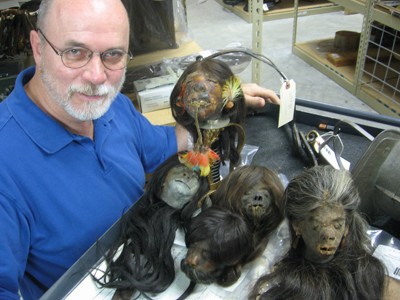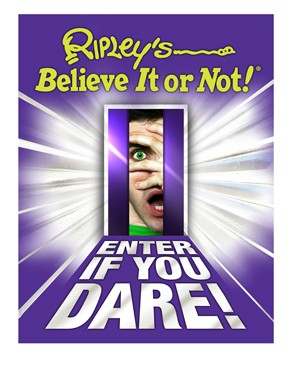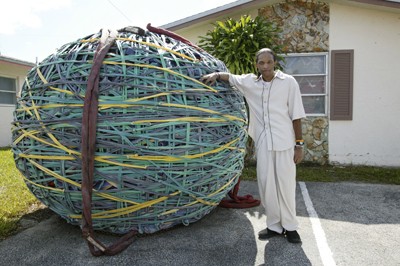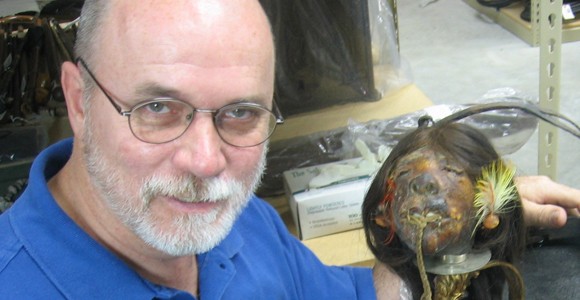Edward Meyer Interview: 'Believe It or Not!' Author and Curator on New Ripley's Book
Written by Melissa Parker, Posted in Interviews Authors
For over 30 years Edward Meyer has traveled around the world collecting unusual stories and unbelievable artifacts to fill Believe It or Not! books and museums. He is a walking encyclopedia of information, some strange, some gross – but all true!
Meyer has acquired over 20,000 different museum artifacts, everything from a pin valued at $1 million dollars, to a two-trunked elephant, to Marilyn Monroe’s lingerie, to Lee Harvey Oswald’s mortuary toe tag, to a meteorite from Mars. The list is endless.
"The thing I’m most proud of buying is 160 feet of the Berlin Wall. It’s 16 ten-foot sections. Most people were there chopping away little tiny pieces to put in their pocket or their suitcase, but I was there to buy whole sections."
Editor of the famous Ripley’s Believe It or Not! newspaper syndicated cartoon, producer of countless Ripley museum films, and a researcher for over 200 hundred Ripley television shows, Meyer has appeared on radio and television programs around the world as the Ripley historian and raconteur, the man with the world’s best job!
In August 2010, Ripley Publishing launched a new annual, the seventh in its multimillion-bestselling series, Ripley’s Believe It or Not! Enter If You Dare! The book is an all-new collection of the strangest stories and features from around the globe.
Melissa Parker (Smashing Interviews Magazine): Edward, please tell me a little about Robert Ripley, the creator of Ripley’s Believe It or Not! and how the museums began.

Edward Meyer holds shrunken heads (Wellons Communications)
Edward Meyer: Robert Ripley was born in 1890 in Santa Rosa, California. His first job was with The San Francisco Chronicle in 1909 and he was hired to be a newspaper cartoon illustrator. This was a time where it was basically “pre photography” in newspapers so each paper would have a couple of staff illustrators who would “draw” the news. Ripley did that in California for about 4 ½ years then moved to New York City and was doing the same thing through the teens. His specialty was always sports, but basically he drew whatever the editor told him to draw.
On December 19, 1918 Ripley drew a series of seven little sketches of sports personalities who weren’t very good at their sports. They had done something wrong and he entitled the sketches “Believe It or Not!” implying that these people are famous yet they’re such poor athletes. It was a pretty big overnight hit and the editor soon asked him to do one or two of these a week.
A couple of years later Ripley takes his first trip around the world, 1922 into 1923. He comes back with a note pad full of pictures and cultural strange stories that the typical American wouldn’t know. Ripley puts these out in a continuous diary type format in the newspaper, “A Day in Japan,” “A Day in India,” and does it as a series. It’s so successful that he gives up having sports cartoons and now he’s doing “Believe It or Not!” seven days a week.
The first Ripley book came out in 1929 and it’s basically a collection of the things he’d been drawing for the last decade. The book was such a hit that William Randolph Hearst, one of the richest men in the world and certainly the number one newspaper tycoon, hired Ripley and changed Ripley’s personal history and probably the history of newspapers as well. But Ripley goes from being a New York guy with a local following to an international celebrity.
Through the 1930s financed by Hearst, Ripley is able to travel the world and acquires the nickname “the modern Marco Polo” because he goes to 201 countries. He’s a high paid lecturer, he does a series of short films in the early 30s, and in 1933 he opens his first museum in Chicago which he calls an “odditorium.”
That’s basically the foundation of our company. The first cartoon is 1918, the first book is 1929, the first museum is 1933, and we’re still doing all of that here 92 years later. The cartoon is the longest continuous newspaper cartoon in the world, our museums are now up to 32, and we’re probably at about 150 books doing at least one a year and some years as many as ten. The last seven years we’ve done an annual high-end glossy colorful coffee table book. This year’s is called Enter If You Dare!
Melissa Parker (Smashing Interviews Magazine): One of my favorite Ripley’s museums is in Gatlinburg, Tennessee.
Edward Meyer: We’ve been in Gatlinburg since 1970. Gatlinburg as a town has been very good to us. Around here we sort of joke that it’s “Ripleyville” because we’ve got an aquarium there, a haunted house, and a couple of mini golf courses. It is our single biggest attraction town. We have 11 different businesses in that town.
Melissa Parker (Smashing Interviews Magazine): How long have you been at Ripley’s, Edward?
Edward Meyer: I’ve been here longer than Mr. Ripley and going on 34 years now. My primary job with the company is to buy the exhibits for all of our museums. I started with the company as editor of the cartoon and I’m still involved in the cartoon on a daily basis. I’m also one of the editors of our book program.
Melissa Parker (Smashing Interviews Magazine): Do you have an estimated number of how many exhibits you’ve personally acquired?
 Edward Meyer: I usually throw out the number 20,000. I’ve been the acquisitions guy for about 26 of the 33 years I’ve been with the company. We aim to do 1,000 a year, but if we averaged maybe 800 or so that would get you at least 20,000.
Edward Meyer: I usually throw out the number 20,000. I’ve been the acquisitions guy for about 26 of the 33 years I’ve been with the company. We aim to do 1,000 a year, but if we averaged maybe 800 or so that would get you at least 20,000.
Melissa Parker (Smashing Interviews Magazine): Do you have favorite places to go to locate weird items?
Edward Meyer: Both to find weird things and just to go … I love India and China which are both Ripley’s favorite countries as well. They’re exotic and so totally different than America. Every day and every hour brings about a new wonder when you’re in those countries.
Melissa Parker (Smashing Interviews Magazine): Is the smallest man in the world from India?
Edward Meyer: He’s actually from Nepal which is a little country just north of India. The smallest woman in the world is from India so the two of them are from the same part of the world. A couple of months back we had Khagendra Magar with us in New York City. He’s 22 ½ inches high and weighs only 10 pounds at age 18. He’s the world’s smallest man by quite a bit, by a couple of inches and several pounds lighter than the next guy.
One of the other stories in our book is about a big fat cat that’s over 20 pounds so he’s twice as big as Magar. My daughter was 24 inches at birth so she was bigger than this 18 year old. There are many people born at 9 or 10 pounds so he’s not much bigger than the average newborn and he is 18 years old.
Melissa Parker (Smashing Interviews Magazine): Do you have a list of items you search for?
Edward Meyer: Well, it’s more like, “Wow that’s pretty cool. Let’s buy that or put that in our book.” Right now we’re working on a fairly extensive renovation to our museum in Hollywood so for the year 2010 my emphasis has been on Hollywood celebrities and items related to the movies that we’ll add to our museum there. But in general I’m looking for anything that is odd, unusual, one of a kind, something the average person hasn’t seen to get what I call the “wow factor.” I want people to look at it and go, “Wow, I’ve never seen that!” or “Wow that’s really amazing!”
Melissa Parker (Smashing Interviews Magazine): If you had to list your favorite oddities what would they be?
Edward Meyer: It would probably change every time you asked me, but certainly one of the most unusual things I’ve ever come across is a full size two-trunked elephant. We have the head which weighs a couple of thousand pounds by itself and measures about 10 foot by 10 foot. We have the head taxidermied in our museum in San Antonio. The two trunks are over five foot tall each, both fully developed and both fully functional.
Animal oddities have a long history at Ripley’s Believe It or Not! but normally you’re dealing with domestic animals like cows, pigs, and sheep. Any deformed freak wild animal catches my interest and obviously an elephant being the biggest animal on the land has got to be a great Believe It or Not!
The thing I’m most proud of buying is 160 feet of the Berlin Wall. It’s 16 ten-foot sections. Most people were there chopping away little tiny pieces to put in their pocket or their suitcase, but I was there to buy whole sections. I came away with 16 ten-foot sections so it’s big enough to wall my office and make myself a little castle (laughs).
Obviously I consider the fall of the Berlin Wall one or two of the most important things in the 20th century. Perhaps the creation of it is slightly more important than the fall of it, but between the two it’s a history changing moment. Personally I love the odd and the unusual but the historical items I bought are the ones I’m most proud of.
Melissa Parker (Smashing Interviews Magazine): What are some of the most popular items with the public?

Ripley's - Joel Waul stands with the rubber band ball he created which is the largest in the world (Ripley Publishing)
Edward Meyer: Historically traditionally everybody loves the genuine shrunken heads from the Jivaro Indians of South America. We’ve been displaying them since the 30s. People expect to see them at Ripley’s. It’s kind of our iconic image. There are other museums that have them, but not as many. Certainly Ripley’s has the biggest collection of shrunken heads in the world. We have approximately 120 of these. Everyone wants to see a shrunken head.
Now in terms of today the general public wants to play. They want to press buttons and turn switches. so things today most popular are electronically based. We did a wonderful display of a 13-foot long matchstick space ship Challenger in our museum in San Francisco. By itself it is a pretty strong exhibit and certainly one of a kind. We did a really good video presentation that tells you all about the real space shuttle as well as the one you’re looking at. People get to punch buttons and see different things light up. It’s immensely popular with people of all ages to interact and become part of the actual display.
Melissa Parker (Smashing Interviews Magazine): Are people just fascinated with the unusual?
Edward Meyer: Well, the longevity of our company and our products is all about human curiosity. We’re trying to find things that people haven’t seen to get their gut reaction that something is amazing because it’s not familiar. Once you’ve got one person’s interest you hope they turn around and tell somebody else. That word of mouth very much sustains us.
People in general are curious by nature. Most of us have a nice education, but there are always things outside of our comfort zone that no one ever taught you about whether it’s deformed elephants or whatever it may be. There’s a real element of education and learning curve that gets people deep into our books. Our books are designed that you won’t necessarily read them from cover to cover. Enter If You Dare! has 12 very distinct chapters. I truly believe there’s at least a chapter for everyone. Even if you don’t read the whole book, everybody’s going to find something that’s going to amaze them.
Melissa Parker (Smashing Interviews Magazine): I enjoyed the special tribute to Coney Island.
Edward Meyer: I personally have never been to Coney Island, but it has a long history as one of the entertainment capitals of America and dates back almost 200 years now. It’s kind of synonymous with the circus, the museum, and the attractions. At one time Coney Island was the place to go so there is a lot of history there. What we’ve done is a foldout spread showing the timeline and how it’s changed over the years. It’s truly one of the great American places.
Melissa Parker (Smashing Interviews Magazine): Edward, do you have difficulty talking to people with deformities? The woman with the elephant nose comes to mind and can be seen in the book.
Edward Meyer: I guess I’m kind of hardened but yes, obviously. I never met the lady with the elephant nose. I’m sure she’s had a difficult life with public mockery and just trying to hide it. There is a pair of young women that are joined at the head and they’re both wonderful ladies, totally different personalities, but it is physically shocking and hard to look at. Typically that kind of abnormality is something I feel the world should know about. I don’t think you can hide it and I think we only learn to be more understanding by facing our demons and looking them in the eye. But it is hard. It’s not pleasant and it’s difficult to say the right things and avoid saying the wrong things.
There’s a famous couple of blues musicians, Sonny Terry and Brownie McGhee and they did a series of TV commercials for polio at one point. Brownie McGhee was crippled with a very severely deformed leg and Sonny Terry was blind yet these two had a long musical career together. They were over 40 years as a duo, traveled the world, very successful, and made hundreds of records. The commercial said, “Deformity is not our problem. It’s yours.” I’ve always felt that was a very strong true message that you, as the observer, have to overcome your fears and be warm and open to hardships other people are going through.
Melissa Parker (Smashing Interviews Magazine): I guess it depends on what they decide to do with their lives, hide away with their deformities or share them with the public.
Edward Meyer: Khagendra, who we mentioned earlier, is not quite as severe an example but obviously his family knows that he can get some popularity/money from touring as the world’s smallest man. But until he was about 15 they hid him away. The rest of the world had no idea.
Melissa Parker (Smashing Interviews Magazine): Do you have an average yearly attendance figure for the museums?
Edward Meyer: All of them are different sizes but a good average number is 200,000 at each location. We publicly announce that we get 13 million visitors a year out of all our attractions but I don’t know if anybody has that broken down. A typical Ripley museum is around 200,000 at ones such as San Francisco, New York, and London, with big urban cities being considerably higher than that.
Melissa Parker (Smashing Interviews Magazine): What are the museum location requirements?
Edward Meyer: Roughly 70% of our museums are franchised. We will not franchise to a location we don’t think can sustain it. If somebody comes to us and wants to try, we will do our homework and typically it’s their money. but we will advise if we don’t think it’s going to work. It’s not worth the setup just to tear it down if it fails. But urban is not really a criteria.
In places like Gatlinburg where the town population is probably less than 20,000, they get 10 million visitors a year. High tourist traffic is much more important than a stable large population. The people who live in San Francisco may only go to Ripley’s once every five years, but people visiting San Francisco are the folks we are trying to get in the door.
Melissa Parker (Smashing Interviews Magazine): What is the expected growth of Ripley’s in terms of museums and other attractions?
Edward Meyer: We attempt to do two new buildings a year. Some years are better than others but we hope to continue to grow forever. I would say that there’s not too many real strong locations left in America, but South America is 100% untapped. We have a basis to believe we could be successful in India and China, so we will continue to expand internationally if we run out of places in America. We’re currently in 11 countries and there are about 250 to choose from.
Melissa Parker (Smashing Interviews Magazine): You certainly have a fascinating job. I’ll bet it makes for interesting dinner conversation.
Edward Meyer: Well, it does. I firmly believe I get the world’s best mail. I regularly get told I have the world’s best job. I’m not sure that’s totally true but it’s a very good job. I’ve been here a long time because I love it. It’s an exciting company with lots of things happening.
We’re trying to make a movie. We have books all of the time and we have new museums being built. We’ve got new projects. We’re looking at building a new aquarium. We’re also the owners of Guinness World Records and we’re trying to come up with a new museum concept for that.
Melissa Parker (Smashing Interviews Magazine): Edward, thanks so much for the very interesting and informative talk.
Edward Meyer: Our pleasure. The book can be bought at ripleys.com or just about any department store or fine bookstore. It makes a great gift this time of year.
© 2010 Smashing Interviews Magazine. All rights reserved. This material may not be published, broadcast, rewritten or redistributed without the express written consent of the publisher.

